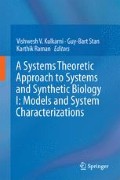Abstract
In 1864, Waage and Guldberg formulated the “law of mass action.” Since that time, chemists, chemical engineers, physicists and mathematicians have amassed a great deal of knowledge on the topic. In our view, sufficient understanding has been acquired to warrant a formal mathematical consolidation. A major goal of this consolidation is to solidify the mathematical foundations of mass action chemistry—to provide precise definitions, elucidate what can now be proved, and indicate what is only conjectured. In addition, we believe that the law of mass action is of intrinsic mathematical interest and should be made available in a form that might transcend its application to chemistry alone. We present the law of mass action in the context of a dynamical theory of sets of binomials over the complex numbers.
Access this chapter
Tax calculation will be finalised at checkout
Purchases are for personal use only
References
Adleman L (1999) Toward a mathematical theory of self-assembly. Technical Report 00–722, University of Southern California. Department of Computer Science
Ahlfors L (1979) Complex analysis. McGraw-Hill, International Series in Pure and Applied Mathematics
Bernstein DS, Bhat SP (1999). Nonnegativity, reducibility, and semistability of mass action kinetics. In: IEEE conference on decision and control. IEEE Publications, pp 2206–2211
Eisenbud D, Sturmfels B (1996) Binomial ideals. Duke Math J 84(1):1–45
Feinberg M (1995) The existence and uniqueness of steady states for a class of chemical reaction networks. Arch Ration Mech Anal 132:311–370
Gatermann K, Huber B (2002) A family of sparse polynomial systems arising in chemical reaction systems. J Symbolic Comput 33(3):275–305
Guldberg CM, Waage P (1986) Studies concerning affinity. J Chem Educ 63:1044
Hirsch MW, Stephen Smale RLD (2004) Differential equations, dynamical systems, and an introduction to chaos, 2nd edn. Elsevier Academic Press, Amsterdam
Horn FJM (1974) The dynamics of open reaction systems. In: Mathematical aspects of chemical and biochemical problems and quantum chemistry, vol VIII. In: Proceedings SIAM-AMS symposium on applied mathematics, New York
Horn FJM, Jackson R (1972) General mass action kinetics. Arch Ration Mech Anal 49:81–116
Irwin MC (1980) Smooth dynamical systems. Academic Press
Ito K (ed) (1987) Encyclopedic dictionary of mathematics. MIT Press, Cambridge, Massachusetts
Narayan S, Mittal PK (2003) A textbook of matrices, 10th edn. S. Chand and Company Ltd, New Delhi
Sontag ED (2001) Structure and stability of certain chemical networks and applications to the kinetic proofreading model of T-cell receptor signal transduction. IEEE Trans Autom Control 46:1028–1047
Acknowledgments
This work benefitted from discussions with many people, named here in alphabetical order: Yuliy Baryshnikov, Yuriy Brun, Qi Cheng, Ed Coffman, Ashish Goel, Jack Hale, Lila Kari, David Kempe, Eric Klavins, John Reif, Paul Rothemund, Robert Sacker, Rolfe Schmidt, Bilal Shaw, David Soloveichik, Hal Wasserman, Erik Winfree.
Author information
Authors and Affiliations
Corresponding author
Editor information
Editors and Affiliations
Rights and permissions
Copyright information
© 2014 Springer Science+Business Media Dordrecht
About this chapter
Cite this chapter
Adleman, L., Gopalkrishnan, M., Huang, MD., Moisset, P., Reishus, D. (2014). On the Mathematics of the Law of Mass Action. In: Kulkarni, V., Stan, GB., Raman, K. (eds) A Systems Theoretic Approach to Systems and Synthetic Biology I: Models and System Characterizations. Springer, Dordrecht. https://doi.org/10.1007/978-94-017-9041-3_1
Download citation
DOI: https://doi.org/10.1007/978-94-017-9041-3_1
Published:
Publisher Name: Springer, Dordrecht
Print ISBN: 978-94-017-9040-6
Online ISBN: 978-94-017-9041-3
eBook Packages: Biomedical and Life SciencesBiomedical and Life Sciences (R0)

